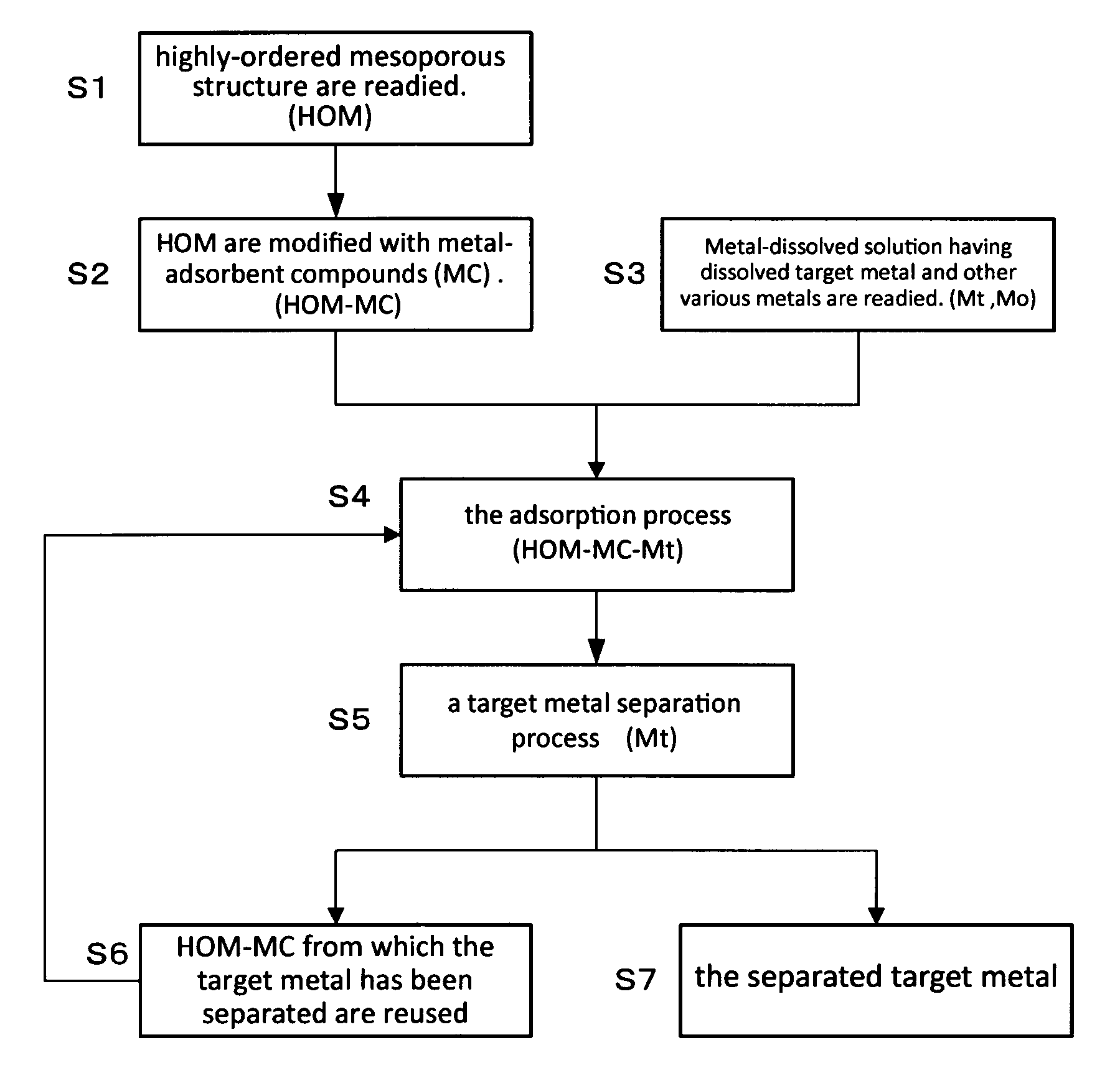Method for extraction and separation of lanthanoid elements and actinoid elements, and means for extraction and separation of lanthanoid elements and actinoid elements
a technology of lanthanoid elements and lanthanoid elements, applied in the field means for extraction and separation of lanthanoid elements and actinoid elements, can solve the problems of high recovery cost, complex process for recovering desired metals (target metals), and price fluctuations of such metals that cannot be easily controlled and controlled. , to achieve the effect of improving recovery efficiency, fast adsorption response, and large surfa
- Summary
- Abstract
- Description
- Claims
- Application Information
AI Technical Summary
Benefits of technology
Problems solved by technology
Method used
Image
Examples
embodiment 1
[0068]The present embodiment is an example of the use of a HOM modified with an azo reagent to recover one of the lanthanoid elements. The azo reagent that was used is DTAR (4-(2-thiazylazo)6-dodecylresorcinol). As comparison examples 1 and 2, a similar method of adsorption / separation / recovery was tried also using nitrogen-containing non-color reacting spectroscopic reagents (N,N′bis(salicylidene) dodecane-1,12-diamine (BSDD) and 2-hydroxy-3-((2-mercaptophenylimino)methyl)benzoic acid (HMPB)). “Non-color reacting spectroscopic reagent” refers to organic indicator dye reagents that do not exhibit a color reaction when interacting with lanthanoid elements or actinoid elements.
[0069]The HOM was obtained by mixing TMOS (tetramethoxysilane) and surfactant F108, which provides a template structure, at a ratio of 0.7 (TMOS) to 1 (surfactant F108). The solution was then heated to 50° C. to 60° C. and stirred for 1 to 2 minutes. This was followed by the addition of hydrochloric acid and a ca...
embodiment 2
[0072]FIG. 8 shows photos (top portion of the figure) of the color reaction and the UV-vis spectroscopy that was obtained with a HOM silica modified with 4-(2-pyridylazo) resorcinol (PAR) serving as the metal-adsorbent compound when only Yb3+ ions were added in different concentrations (0 ppb, 0.5 ppb, 1 ppb, 5 ppb, 10 ppb, 50 ppb, 100 ppb, 500 ppb, 1000 ppb (1 ppm) and 2000 ppb (2 ppm)) to a solution with a pH of 7.0 in an experiment to measure wavelength dependence of light absorbance. FIG. 8 shows a peak near a light wavelength of 400 nm with a significant concentration dependence, confirming the capturing of lanthanoid element (Yb) complexes by the HOM-MC. FIG. 9 shows the Yb adsorption capacity of the PAR-modified HOM-MC that was determined by changing the pH of a solution (at room temperature) having 2 ppm of dissolved Yb as the sole lanthanoid element by the addition of NaOH and 0.2M (mole) of 3-morpholinopropanesulfonic acid (MOPS). The 3-morpholinopropanesulfonic acid (MOPS...
embodiment 3
[0073]FIG. 10 shows the effects of the addition of a lanthanoid element ion (Dy3+) to a HOM silica that was modified with N,N′disalicylidene-4-nitro-phenylenediamine (DSNPD) which exhibits a quenching reaction. The figure shows the results of the measurement of the fluorescence signal from a DSNPD-modified HOM-MC for a 20 ml solution with a pH of 7 at 25° C. with the lanthanoid element ion added. The solution was adjusted to have a pH of 7 by the addition of NaOH and 0.2M (mole) of 3-morpholinopropanesulfonic acid (MOPS). FIG. 10 shows that as the amount of added lanthanoid element (Dy3+) increases, the intensity of the fluorescence signal decreases, confirming that the lanthanoid element complexes were captured by the DSNPD-modified HOM-MC.
PUM
| Property | Measurement | Unit |
|---|---|---|
| atomic number | aaaaa | aaaaa |
| atomic number | aaaaa | aaaaa |
| atomic number | aaaaa | aaaaa |
Abstract
Description
Claims
Application Information
 Login to View More
Login to View More - R&D
- Intellectual Property
- Life Sciences
- Materials
- Tech Scout
- Unparalleled Data Quality
- Higher Quality Content
- 60% Fewer Hallucinations
Browse by: Latest US Patents, China's latest patents, Technical Efficacy Thesaurus, Application Domain, Technology Topic, Popular Technical Reports.
© 2025 PatSnap. All rights reserved.Legal|Privacy policy|Modern Slavery Act Transparency Statement|Sitemap|About US| Contact US: help@patsnap.com



